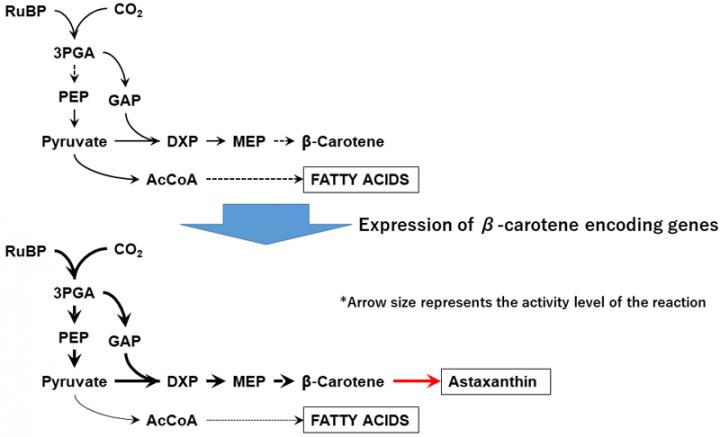
Credit: Kobe University
A research group led by Professor HASUNUMA Tomohisa of Kobe University’s Engineering Biology Research Center have succeeded in synthesizing the natural pigment astaxanthin using the fast-growing marine cyanobacterium Synechococcus sp. PCC7002.
This process required light, water and CO2 to produce the valuable antioxidant astaxanthin from the cyanobacterium host at a faster rate and with lower contamination risks than previous methods of biologically synthesizing this useful substance. In addition, dynamic metabolic analysis revealed that astaxanthin production enhances the central metabolism of Synechococcus sp. PCC7002.
It is hoped that these developments could be utilized to meet the demand for natural astaxanthin in the pharmaceutical and nutritional industries, amongst others, in the future.
The results of this study were first published in the international journal ‘ACS Synthetic Biology’ on October 25 2019.
Introduction
Carotenoids are pigments found in nature- the most well-known being the orange β-carotene (beta-carotene), which is found in carrots among other vegetables, fruits and plants. Various studies on different carotenoids have suggested that they can protect against cancers, premature aging and degenerative diseases.
Astaxanthin (pink carotenoid) is the strongest antioxidant among known carotenoids. It is used as a natural coloring in aquaculture, cosmetic, nutrition and pharmaceutical industries among others, due to its enhancement of immune responses and anti-inflammatory properties. For example, it is utilized as an additive in chicken and fish feed.
Currently, the majority of commercial astaxanthin is chemically synthesized from petrochemicals. This enables large amounts to be produced in order to meet demand. However, there are concerns about the safety of consuming astaxanthin synthesized from petrochemicals, and as a result the demand for natural astaxanthin is increasing.
Research Background
The freshwater alga Haematococcus pluvialis produces astaxanthin naturally and is responsible for the pink spots of astaxanthin commonly seen in birdbaths. For commercial astaxanthin production, Haematococcus requires a complex 2-stage process (Figure 1, top). After the first growth stage, Haematococcus is placed under inductive stress conditions such as nitrogen starvation or high light irradiation. This induces the plant to form hematocysts and produce astaxanthin in the second stage. However the slow growth in the first stage and subsequent cell deterioration in the second stage increase the risk of contamination. Furthermore, high light irradiation extrapolates production costs.
Consequently, current methods of producing natural astaxanthin are not commercially viable enough for large-scale production. It is hoped that this powerful antioxidant carotenoid could be further utilized for human consumption in the nutrition and pharmaceutical industries if more efficient ways of producing it biologically are developed.
The current study sped up the growth rate and reduced the contamination risks in biosynthesizing astaxanthin. The researchers succeeded in producing astaxanthin using the fast-growing marine blue-green algae species, or cyanobacterium, Synechococcus sp. PCC7002 as a host. This algae does not inherently produce astaxanthin, however by integrating β -carotene encoding genes into the Synechococcus, the expressed genes only require water, light and CO2 in order to produce astaxanthin. This single stage method (Figure 1, bottom) does not require subjecting the cells to stress conditions and enabled astaxanthin to be produced in a shorter time period compared to the Haematococcus method. In addition, it is proposed that the rich salt concentration in Synechococcus could also lower the risk of contamination.
Research Methodology:
As previously mentioned, Synechococcus sp. PCC7002 does not inherently produce astaxanthin. Therefore it was necessary to take the encoding genes for β-carotene hydroxylase and β-carotene ketolase from the marine bacterium Brevundimonas sp. SD212 and integrate them into the Synechococcus. The genes were then expressed to biosynthesize astaxanthin. The host Synechococcus sp. PCC7002 was then able to produce astaxanthin via photosynthesis under a stress-free level of light similar to natural sunlight. As shown in Figure 2, the production of pink astaxanthin makes the solution turn a darker green color.
This study is thought to be the first in the world to succeed in producing astaxanthin utilizing this particular marine cyanobacterium. With CO2 as the sole carbon source, this modified strain of Synechococcus sp. PCC7002 yielded 3mg/g dry cell weight astaxanthin, a production speed of 3.35mg/L/day. This is believed to be highest rate achieved so far using green algae.
A dynamic metabolic profiling method developed by Professor Hasunuma et al. was used to analyze the metabolics inside the cells during astaxanthin production. This analysis revealed an increase in fractions of phosphates- in particular deoxyxylulose 5-phosphate (DXP), glyceladehyde 3-phosphate (GAP); and methylerithritol 4-phosphate (MEP). Furthermore, the level of the intermediary deoxyxylulose 5-phosphate (DXP) in the nonmevalonate pathway (a precursor metabolic pathway for astaxanthin production) also increased (Figure 3). In vivo C-labelling revealed that the carbon flow in the central metabolism was enhanced by the expression of the β-carotene encoding genes.
These results indicate that astaxanthin producing cells are active in the initial metabolic stage. The reason for this is believed to be due to the cyanobacteria enhancing its central metabolism and the nonmevalonate pathway in order to try to replenish pigments such as β-carotene that are being used to synthesize the astaxanthin. In other words, astaxanthin production enhances the central metabolism of Synechococcus sp. PCC7002 to compensate for the lack of light harvesting pigments.
It is hoped that further metabolic pathway engineering could reduce potential bottlenecks and further increase astaxanthin production.
Further Research:
Overall, this study showed that the modified Synechococcus sp. PCC7002 is a promising host for producing astaxanthin biologically through photosynthesis. This could be investigated further by trying to synthesize various other useful substances utilizing Synechococcus sp. PCC7002.
In addition, it is hoped that the dynamic metabolic profiling method developed during this research could be utilized to improve understanding of metabolic processes in microorganisms, plants and animals.
###
Media Contact
Verity Townsend
[email protected]
81-788-035-282
Original Source
https:/
Related Journal Article
http://dx.




